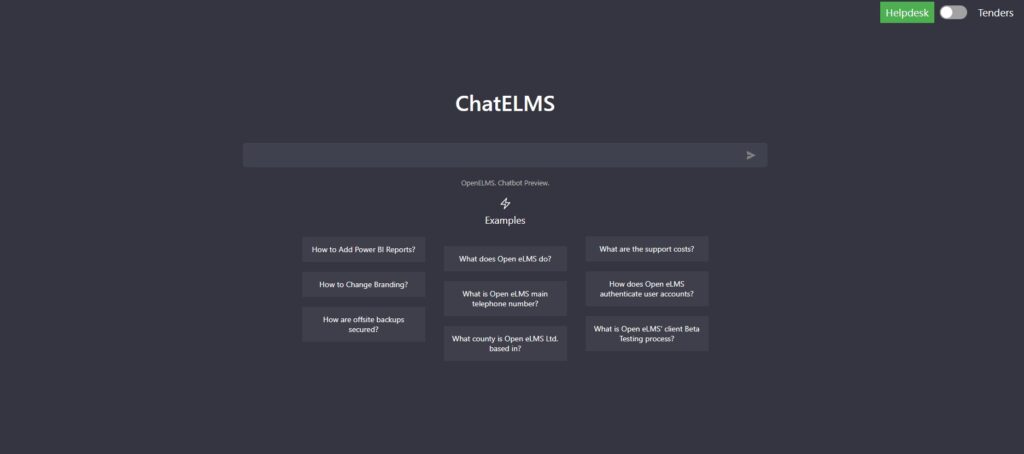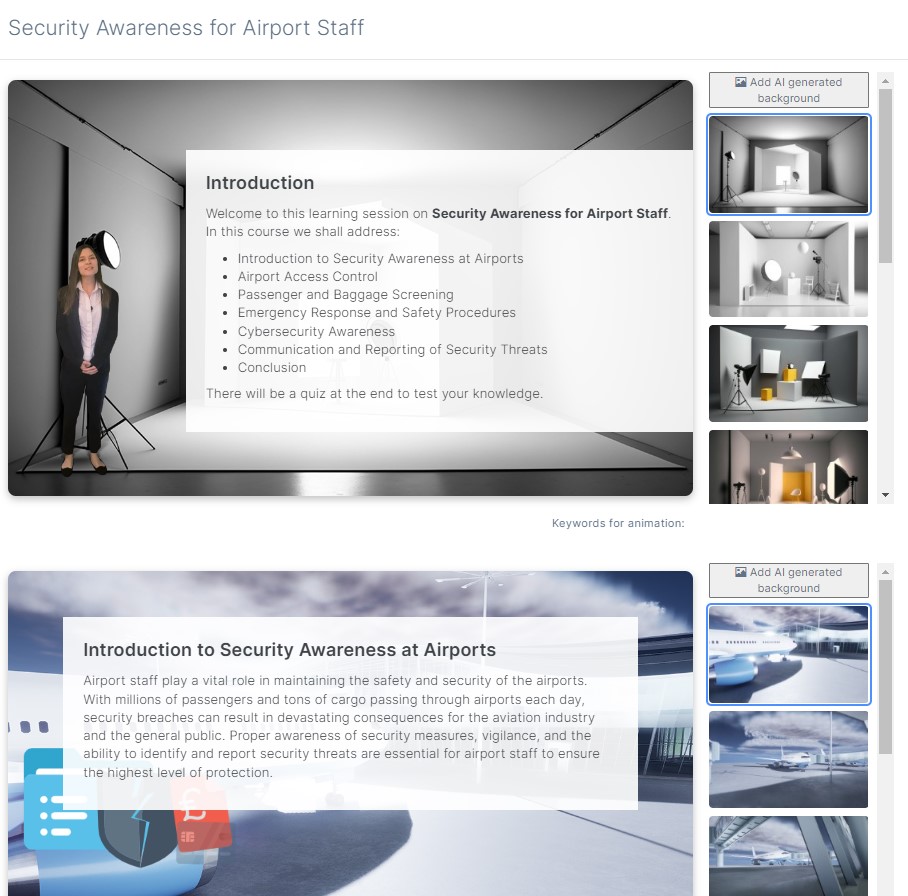Reasons to Never Use Artificial Intelligence to Generate eLearning

When it comes to AI and eLearning, let’s be honest — there are some pretty reasonable concerns floating around. Will it stick to the script? Is it just making stuff up? Will my learners feel like they’re being taught by a soulless robot? Enter Open eLMS AI, the game-changer that addresses these worries head-on. Here’s a breakdown of how it nails the balance between cutting-edge tech and user-friendly functionality. 1. Trusting AI to Focus the Message (and Not Go Rogue) One of the biggest fears is that AI might veer off course and create content that misses the mark. Nobody wants a lesson about biology suddenly referencing quantum physics (unless you’re into that kind of crossover). Open eLMS AI takes this concern seriously. It lets you upload your own documents and adjust interpretation settings with a simple slider. Want the AI to stick to your exact words and phrases? No problem. Prefer it to explore related ideas and sprinkle in some broader knowledge? Easy. This slider puts the power in your hands, ensuring the content is focused, relevant, and completely under your control. Think of it as having a super-smart assistant that actually listens. 2. No More “AI Hallucinations” If you’ve heard horror stories of AI making up facts (hello, “AI hallucinations”), you’ll be glad to know those days are mostly behind us. Open eLMS AI takes advantage of the latest advancements in AI tech to generate scripts that are accurate, trustworthy, and ready to teach. It’s like how modern AI can now predict the weather better than some meteorological offices. Open eLMS AI applies that same precision to your eLearning materials. You can confidently build lessons knowing your content won’t be undermined by random, made-up nonsense. 3. Injecting the Human Touch One big complaint about AI-generated content is that it can feel, well, robotic. We’ve all seen it: flat presentations, monotone narrations, and zero personality. Open eLMS AI says, “Not today!” This platform allows you to switch up the delivery style, whether you’re aiming for serious professionalism, a touch of humor, or something more conversational. Its voiceovers? Almost indistinguishable from real human voices. And for those who like to take the reins and add their own designs, the drag-and-drop editor makes it a breeze to customize lessons. Add some media, sprinkle in interactivity, and boom — you’ve got engaging, dynamic eLearning that feels anything but lifeless. 4. But My Current Program Already Has AI… Sure, there are other eLearning platforms with AI tools, but Open eLMS AI isn’t just “another tool.” It’s the only true AI powered multimedia authoring system out there, combining over two decades of media production and software expertise with two years of focused AI development. Some quotes from users include: “Buy it, you will not regret it! I purchased it today, created one course, was amazed by the result and came here immediately to salute to developers. I look forward to seeing the continued growth of this amazing product.” “This A.I. course creator is the best that I’ve used. I own about (7) A.I. course builders and none of them are this easy to use and professional looking.” “Great product for rapid course development utilizing AI content development, text, and imagery. Excellent customer service support.” This isn’t your run-of-the-mill AI that churns out cookie-cutter slides. Open eLMS AI is a powerhouse built to handle multimedia-rich projects, whether you’re creating videos, animations, or interactive modules. It’s a one-stop shop for elevating your eLearning game. Why Open eLMS AI Stands Out In a sea of AI tools, Open eLMS AI rises above by addressing the most common concerns head-on: Focused Content: It sticks to your message or expands thoughtfully, depending on your preference. Factual Accuracy: No hallucinations, just reliable information. Human-Like Presentation: Customizable delivery styles and lifelike voiceovers ensure an engaging experience. Unmatched Expertise: A multimedia authoring system with years of know-how backing it up. Whether you’re new to eLearning or a seasoned pro, Open eLMS AI bridges the gap between cutting-edge AI capabilities and the hands-on control you need to create impactful courses. So, what are you waiting for? Step into the future of eLearning with Open eLMS AI — where tech meets trust, creativity, and a whole lot of awesome.
The Essential Features of a Modern Learning Management System

The integration of technology into learning processes is not just a luxury—it’s a necessity. The days of traditional, one-size-fits-all teaching methods are fading, replaced by dynamic, personalised learning experiences. At the heart of this transformation lies the Learning Management System (LMS), a vital tool that provides a comprehensive platform to deliver, track, and manage educational content. Selecting the right LMS is crucial for meeting the diverse needs of both learners and educators. This guide outlines the essential features to prioritise when choosing a modern LMS to ensure it fosters an engaging, effective, and efficient learning environment. Key Takeaways Adaptive Learning Pathways: Create personalised learning experiences tailored to individual learner’s strengths and areas for improvement. AI-Powered Recommendations: Utilise artificial intelligence to suggest relevant content, keeping learners engaged and continuously progressing. eLearning Content Generation: Transform text and documents into interactive, multimedia-rich eLearning modules quickly and efficiently. Skills Analysis and Tracking: Track and analyse user skills to make informed training decisions and address competency gaps. Custom Forms for Personnel Management: Streamline administrative processes with customisable forms for managing performance and HR data. Comprehensive eLearning Library: Access a wide range of topics and skills with a consistently designed, customisable eLearning library. Smart Classrooms: Enhance learning by integrating online sessions with face-to-face interactions, supported by comprehensive booking and collaboration tools. Surveys and Quizzes: Use regular assessments to provide immediate feedback, ensuring alignment with educational goals and adapting learning pathways as needed. Adaptive Learning Pathways A key feature of a modern LMS is the ability to create personalised learning pathways. These pathways adapt to the unique characteristics and needs of each learner. By leveraging data on learner performance, preferences, and progress, the LMS can tailor the learning experience, offering content and activities that align with individual strengths and areas for improvement. This adaptive approach ensures learners receive the most relevant and effective instruction, enhancing engagement and outcomes. AI-Powered Recommendations Modern LMS platforms harness the power of artificial intelligence to offer personalised learning recommendations. By analysing learning patterns and characteristics, the system suggests additional content and resources that have benefited other learners with similar profiles. This AI-driven personalisation not only enriches the learning experience but also encourages continuous engagement by presenting learners with new and relevant material tailored to their needs. eLearning Content Generation Producing high-quality eLearning content from text or documents is a significant advantage. For instance, Open eLMS AI features a unique text-to-learning generation tool that utilises multi-modal professional standard AI to transform written content into engaging eLearning modules. This capability allows educators to quickly and efficiently create interactive and multimedia-rich learning materials, ensuring content delivery is both effective and appealing to learners. Skills Analysis and Tracking A robust LMS should include a comprehensive skills analysis feature. This tool tracks the underlying skills of each user, creating a detailed matrix of employee competencies across the organisation. Such analysis is invaluable for making informed decisions about training needs and assignment suitability. By identifying skill gaps and strengths, organisations can tailor their training programmes to address specific needs, ensuring all employees have the necessary skills to perform effectively. Custom Forms for Personnel Management Customisable forms are essential for effective personnel management within an LMS. These forms can be used to gather and manage data on employee performance, training needs, and other HR-related information. The ability to create and use bespoke forms allows organisations to streamline their administrative processes and maintain accurate records, enhancing overall efficiency and compliance. Moreover, integrating an online assessment platform (e.g. Assess) can complement these custom forms by providing comprehensive tools for evaluating employee performance and training outcomes. This integration ensures a more holistic approach to personnel management and development. Comprehensive eLearning Library A modern LMS should offer an extensive eLearning library covering a wide range of topics and skills. The content should have a consistent look and feel, which aids in customisation and ensures a smooth navigation experience for learners. The ability to customise eLearning content is crucial, allowing organisations to tailor the material to their specific needs and branding requirements. Smart Classrooms Integrating smart classrooms into an LMS can significantly enhance the learning experience by blending online learning with face-to-face or webinar sessions. A full booking system, complete with a payments engine if required, is essential for managing these sessions efficiently. Additional features such as lesson recording, chat rooms, collaborative whiteboards, and message boards facilitate social learning and provide opportunities for learners to interact and collaborate, mirroring the benefits of traditional classroom environments. Surveys and Quizzes To assess understanding and ensure learning objectives are met, surveys and quizzes are indispensable tools. They provide immediate feedback to learners and educators, highlighting areas of success and those needing further attention. Regular assessments help maintain alignment with educational goals and allow for adjustments to the learning pathway as needed. Conclusion Choosing the right LMS is critical for maximising the potential of educational and training programmes. By focusing on features such as adaptive learning pathways, AI-powered recommendations, eLearning content generation, skills analysis, custom forms, a comprehensive eLearning library, smart classrooms, and robust assessment tools, organisations can ensure they provide a dynamic and effective learning environment. Open eLMS exemplifies these capabilities, offering a cutting-edge solution that meets the diverse needs of modern learners and educators. For a detailed functional specification of Open eLMS, you can review the document here or access the LMS immediately by registering—your branded site will be set up in seconds. Embracing these features will not only enhance the learning experience but also drive better educational outcomes and foster a culture of continuous improvement and development.
Feeling Stuck? Explore How AI Transforms eLearning Content Development

Are you feeling stuck in developing engaging eLearning content? We’ve been there before, and we understand the struggle. After doing some extensive research, there is a solution: Artificial Intelligence (AI). This article explores how AI is reshaping the landscape of eLearning content development, providing innovative ways to enhance your eLearning courses. Key Takeaways AI is revolutionising eLearning content development by generating and refining course materials to help best put across learning objectives. It allows for personalised learning experiences, enhances learner engagement, and improves learning outcomes. AI facilitates smoother content creation, cuts down on instructional design time in the elearning course development process, and enhances resource efficiency when creating an online course. By using AI in the creation of an eLearning course, educators can create exceptional courses that effectively engage learners. What is Artificial Intelligence (AI)? Artificial Intelligence, often abbreviated as AI, marks a revolutionary advancement in technology. It’s a broad field of computer science dedicated to simulating human intelligence processes by machines. Primarily this involves learning – obtaining data and rules for using the information, reasoning – applying these rules to reach approximate or definitive conclusions and self-correction. Unlike traditional programming that requires explicit instructions for each action, AI systems can learn from experience. They might examine raw data or pre-trained models to recognise patterns and create forecasts based on that knowledge. For instance, it allows our phones to recommend new songs or movies based on what we’ve previously enjoyed. In the realm of e-learning content development, AI has immense potential which would be discussed later in this article. Types of AI-generated Content for Digital Customer Education We want to shed light on the diverse types of AI-generated content used in digital customer education. Personalised course recommendations: AI uses data from past courses to suggest new relevant ones. Adaptive learning paths: These let learners progress at their own pace, adjusting material based on their performance. Interactive video lessons: AI can create engaging elearning content, interactive video for visual learners. Automated voiceovers: With natural speech recognition, AI can produce automated voiceovers for audio content. Real-time language translation: Enables accessibility for a global audience by translating course material into various languages. Virtual assistants or chatbots: These help answer queries, provide additional resources, improving learner engagement. What Are the Benefits of AI-assisted Content Development? Harnessing the power of artificial intelligence drastically improves e-learning course development in multiple ways. Here are a few remarkable benefits: Allows for Tailored Learning Experiences: AI gives us the tools to personalise educational content to match the learning style and pace of individual learners. Enhances Learner Engagement: Engaging learners becomes more manageable with customised feedback, and personalised learning paths facilitated by AI. Streamlines Content Creation: AI accelerates the development process by generating written content, creating graphics and editing videos swiftly and efficiently. Improves Learning Outcomes: Intelligent algorithms can analyse learner progress and adjust course materials on-the-fly to optimise outcomes based off of a learning objective. Facilitates Continuous Improvement: With AI’s data crunching capabilities, we can derive actionable insights to continuously refine our e-learning courses. Boosts Scalability: Thanks to automated generation of e-learning content, we can scale up training program delivery without compromising on quality to create s successful elearning project. Reduces Instructional Design Time: Advanced authoring tools powered by AI reduce the time it takes instructional designers to develop an entire course from start to finish. Delivers Consistent Training Content: Automated content creation ensures consistency across all training modules – a critical factor for successful e-learning projects. Enables Real-Time Assistance & Feedback: Virtual tutoring and real-time assessment become possible with AI, enhancing learners’ grasp of knowledge and skills during the learning process. Promotes Efficient Resource Utilisation: By streamlining various stages of the e-learning course development process, AI allows team leaders and instructional designers to focus more on critical tasks like setting training goals or understanding learner needs better. How to Use AI to Create Great Course Content To use AI in creating exceptional course content, we follow a simple process. First, we define our goals and learning objectives for the course. Next, we gather data and information from subject matter experts to ensure accuracy and relevance. Once we have the necessary information, AI assists us in generating custom elearning courses that are tailored to our intended audience. We then edit and refine the content to enhance clarity and engagement. Finally, after thorough review, we publish and promote the course to reach as many learners as possible. By utilising AI in these steps, we can create online courses that effectively engages learners and meets their learning needs. Define Goals and Objectives Defining goals and objectives is a crucial step in developing e-learning content. By clearly identifying what you want to achieve, you can create targeted and effective courses that meet the needs of your learners. Start by asking yourself what specific skills or knowledge you want your learners to gain from the course. These goals should be measurable and aligned with your overall training objectives. Next, consider the learning outcomes you expect from the course. These are statements that describe what learners will be able to do after completing the course. By setting clear goals and objectives, you can ensure that your e-learning content is focused, relevant, and impactful for your audience. When defining goals and objectives for your e-learning courses, it’s important to involve key stakeholders such as subject matter experts (SMEs) and instructional designers. They can provide valuable input on what topics should be covered, the level of complexity required, and any specific requirements or constraints to consider during development. This collaborative approach ensures that all perspectives are taken into account when setting goals and objectives for your e-learning content. In summary, defining clear goals and objectives is an essential part of developing successful e-learning courses. It helps guide the creation process by identifying what skills or knowledge learners need to acquire and outlining measurable learning outcomes. By involving stakeholders in this process, you can ensure that your e-learning content meets their expectations while also aligning with
Debunking Insecurities in creating eLearning using AI

Hey there! Today, I want to dive into a topic that’s been on many of our minds: the insecurities surrounding the use of AI in creating eLearning content. With tools like Open eLMS AI promising to churn out top-notch eLearning materials effortlessly, it’s time we address the elephant in the virtual classroom. Are our fears justified, or is it time to embrace AI with open arms? Let’s explore! First things first, let’s acknowledge the concerns. We’ve all heard the whispers that AI might replace educators or dilute the human touch in educational content. It’s a legitimate worry. After all, what’s eLearning without the personal connection that a teacher imparts, right? But here’s where the magic of AI comes into play. Open eLMS AI isn’t here to replace teachers – it’s here to enhance them. Imagine having an AI sidekick that assists educators in creating content that is both engaging and informative. That leaves us with more time to focus on connecting with students, addressing their individual needs, and fostering meaningful discussions. Now, you might be wondering: “Well, that’s all good, but can AI really create content that matches the quality of human-made eLearning materials?” The short answer: yes, and surprisingly well! Open eLMS AI has been trained on vast amounts of educational content, ensuring that the lessons they generate are accurate, up-to-date, and aligned with the curriculum. Let’s face it – we educators sometimes spend hours sifting through information and structuring it into digestible lessons. With AI, this process becomes a breeze. It helps in organizing content logically, ensuring that every piece of information finds its right place. And the result? Crisp, coherent eLearning materials that can help students grasp even the most complex topics without breaking a mental sweat. Now, I get it. Trusting a machine to understand the nuances of education can be nerve-wracking. What if it misinterprets a concept or fails to capture the essence of a subject? But here’s the kicker – AI is continuously learning. It adapts based on user feedback and refines its understanding with every iteration. So, while it might not get it right the first time, it’s determined to improve, just like we do as educators. Another common concern revolves around the uniqueness of content. Will AI churn out cookie-cutter lessons that lack personality? It’s a valid point, but the reality is different. AI-generated content is like a canvas primed for the teacher’s creative strokes. You can personalize and inject your unique teaching style into it. Add anecdotes, real-life examples, and your touch of humor – the AI doesn’t stifle your individuality; it amplifies it. All AI driven tools should be paired with a content editor. For instance, as well as personally instructing the AI to generate lessons as if generated by a unique teacher themselves, using Open eLMS creator, text can be further edited to infuse such personalisations and uniqueness into every lesson. And let’s not forget the silver lining that AI brings to the table: accessibility. Not all educational institutions have access to a treasure trove of resources. AI-driven eLearning authoring system such as Open eLMS AI tools level the playing field, offering quality content to a broader audience. From urban classrooms to remote villages, everyone gets a shot at quality education. So, should we be insecure about using AI in creating eLearning? The answer lies in realizing that AI isn’t an adversary; it’s an ally. It’s not here to replace educators but to empower them. Open eLMS AI acts as force multipliers, freeing up our time and energy to focus on the human aspects of teaching. In a world where technology is transforming every facet of our lives, embracing AI in education is a natural progression. So, my fellow educators and learners, let’s shed those insecurities and dive headfirst into the AI-driven eLearning realm. After all, if we can adapt to smartphones and online learning platforms, why not welcome AI into our educational arsenal with open arms? It’s not about machines replacing us; it’s about machines helping us soar to new educational heights.
From Text Prompt to eLearning Magic

Hello all! Today, I want to talk about something that might sound straight out of a sci-fi movie: using AI to turn text prompts into fully-fledged eLearning content. That’s right – we’re talking about harnessing the power of artificial intelligence to transform a simple idea into a comprehensive learning experience. Intrigued? Let’s dive in! Open eLMS AI is a solution that can do this using a generalised AI knowledge base – such as that used by Chat GTP. You can ask it to produce an eLearning course on any topic and it will do that. But picture this: you have a bunch of ideas, concepts, or information that you or your company has created and you want to turn that information into an engaging eLearning course. Instead of slogging through hours of content creation, what if you could just give a quick text prompt and let the AI handle the rest? That’s where trained AI from uploaded documents comes into play. Imagine you want to create a course on “Coffee Brewing at SunDollars” for your coffee company, SunDollars. You type in a text prompt like, “Create an eLearning course explaining how we make coffee here at SunDollars.” Now, this isn’t some sci-fi mumbo-jumbo; AI is really capable of making this happen. The AI takes your text prompt and gets to work. It digs through its digital brain, analysing tons of uploaded documents, articles, and resources related to coffee brewing at the company. It’s like having a team of researchers at your fingertips, working at lightning speed. The AI distils all that knowledge into structured lessons, modules, and even interactive quizzes. But wait, there’s more. Not only does the AI create the content, but it also designs the eLearning with visually stimulating content such as video presenters, eye-catching graphics and animations to break down complex concepts. But here’s the kicker: the learning experience doesn’t stop at the content. The AI can also design quizzes that test the learner’s knowledge of coffee brewing and can even add interactive questions through the course of the elearning module. It’s like having a personalised tutor guiding you through each step of the learning journey. So what does this mean for the eLearning designer? Well as an eLearning designer myself, we’ve all had those moments where we’re staring at a blank screen, trying to find the right words. AI eliminates that struggle. It generates clear, concise explanations that are as easy to understand as your favourite meme and gives you a design upon which you can embellish. You don’t have to worry about jargon or convoluted sentences; the AI keeps things simple and relatable. With Open eLMS AI you, as a designer, can then step in and add that touch of design magic, editing text and redesigning as you go. The design of eLearning will be so much quicker, but the amount of eLearning demanded from companies will grow as it gets easier to create and personalise eLearning. Why do you need to purchase a one-size-fits-all course that is largely inappropriate for your needs! The AI can now be so easy to produce that courses can be replaced every few months, which contain up to date information. Your eLearning will be refreshed with updated documentation loaded into the AI so that it evolves with you. So is the eLearning designer now redundant? I would say the exact opposite – thankfully! The eLearning designer will now be employed directly by organisations to disseminate the wealth of knowledge within each company. They will be more central to the running and financial success of a company. As such their worth will be enhanced, more job opportunities will occur and wages will rise accordingly. To sum it up, AI isn’t just about automating tasks; it’s about enhancing the learning experience in ways we couldn’t have imagined before. So, don’t be surprised if the next eLearning course you enrol in feels like it was tailor-made for you – thanks to the magic of AI, a simple text prompt and the power of the Open eLMS AI system. Open eLMS AI can be used at www.openelms.ai. Sign up for a free version, else there are paid versions with more features varying from £19.99 to £199.99 per month.
Open eLMS MD Interview on Generative AI tool openelms.ai

Our Managing Director, Emil Reisser-Weston, was interviewed recently by Learning News regarding it’s AI powered elearning authoring system: openelms.ai. In this interview Emil explains how AI is used to automatically generate a script, organize learning objectives, and divide them into different sections within the course. It also generates visuals, videos, and animations, mimicking the process used by human designers who apply design heuristics. Despite sounding unbelievable, the tool has proven to be effective. To gain a comprehensive understanding of this innovative tool, watch the video where Emil Reisser-Weston explains its features and functionality, then visit www.openelms.ai and try it out.
Benefits of creating your own AI engine

Why do I need a custom AI? Open eLMS Chat is a powerful chatbot platform designed to transform your company’s communication dynamics. Powered by a state-of-the-art chat engine, the Open eLMS Chat mirrors the capabilities of Chat GPT4 but is tailored uniquely for your business. The heart of Open eLMS Chat lies in its bespoke admin interface, an elegantly designed system that blends simplicity with powerful features. Not only is it user-friendly, but it also requires no coding skills to customize your chatbot to your brand’s personality, information needs, and preferred interaction styles. Implement your own chatbot This advanced solution allows you to create custom GPT chatbots, trained exclusively on your company’s data, guaranteeing the most personalized responses for your employees and customers. The chatbots can be embedded anywhere within your digital ecosystem, either as a customer-facing tool or an internal communication facilitator. Security is guaranteed The platform provides the option of a Dedicated Server, enhancing privacy and security by hosting your sensitive data in separate repositories. This feature ensures your data stays protected while your chatbot learns and improves from past interactions. Create custom e-learning using your AI When paired with openelms.ai, the synergy is game-changing. Open eLMS AI simplifies and elevates eLearning course creation, turning user-specified topics or existing materials into engaging, interactive eLearning experiences. Meanwhile, Open eLMS Chat serves as a dynamic knowledge hub, allowing organizations to upload, centralize, and manage their knowledge base on dedicated servers. This duo revolutionizes eLearning and communication experiences in organizations, regardless of their size or industry. From small businesses to large enterprises, the Open eLMS Chat is a perfect fit for everyone. Let’s embark on this journey to create a chatbot that is truly a reflection of your brand and meets your unique needs! Key Features Data-Specific Chatbots: Train chatbots on your unique company data, ensuring they provide the most personalized and relevant responses. File Upload Flexibility: Have a wealth of resources at your disposal. Open eLMS Chat supports the upload of various file types, including MP4s, PDFs, PowerPoints, and more. This makes it easy to share resources and information with your chatbot. Ecosystem Integration: Seamlessly embed Chat eLMS into your existing digital ecosystem, providing real-time, interactive communication internally or with your customers. User-Friendly Interface: Our platform is designed to be easily navigable, making it user-friendly even for those without coding skills. Customizing your chatbot becomes an intuitive and effortless process. Optional Dedicated Server: For enhanced privacy and security, opt for a Dedicated Server to host your sensitive data. This ensures your data remains protected while your chatbot continuously learns and improves. Open eLMS AI Integration: Combine Chat eLMS with openelms.ai to create an unparalleled eLearning experience. Use openelms.ai for intuitive course creation and Open eLMS Chat to centralize and manage your knowledge base. With Open eLMS Chat, you’re not just getting a chatbot; you’re investing in a comprehensive communication solution that represents your brand and meets your organization’s unique needs
How to Use AI in eLearning Development in 2023

Personalised Learning: The Impact of AI on the eLearning Industry Artificial intelligence is revolutionising the eLearning industry by providing personalised learning experiences, automating administrative tasks, and enabling better assessment and feedback mechanisms. AI is also making it easier to offer private video hosting, ensuring secure and controlled access to sensitive training content, which is particularly important for corporate and compliance-based learning. We are using the power of AI to make eLearning more efficient, effective, and engaging for learners around the world. We have been making eLearning over the last 20 years, but have found that recently the demand for eLearning has accelerated rapidly. We are creating eLearning for organisations at a faster pace to keep up with demand. We have found that many organisations are now using rapid authoring tools, agile methodologies, and automated processes to speed up the eLearning courseware creation process. This improves productivity but the end results can be questionable. I always say ‘Simply giving someone a paintbrush does not make them an artist.’ At Open eLMS we leverage technologies such as machine learning and adaptive learning. We can use our AI driven eLearning platforms to automatically create personalised content recommendations, assessments, and feedback. This leads to better learning outcomes and higher learner engagement. No longer do we need to design a one size fits all approach to learning. We can use AI to create personalised learning paths and even personalised learning content – down to the individual eLearning course. Key AI Technologies that will transform eLearning: From machine learning to Natural Language Processing Machine learning and deep learning have a significant impact on eLearning by enabling intelligent content creation, automated assessment, and adaptive learning experiences. We have been leveraging these technologies within our own learning platforms. Our technology can analyse learners’ data and behaviour to provide a personalised learning experience. We use Artificial Intelligence to change the learning process from one where the learner will have personalised learning modules suggested and even created for them, rather than searching through a library of course material. We use AI to create eLearning material quickly and easily. Check out our article on Using AI to write eLearning scripts and AI generated scripts. I am sure that very soon it will be standard to create eLearning using AI in the same way we would do a Google Search. eLearning will be automatically created within LMSs by ai systems to satisfy prescribed needs rather than be assigned by Learning Management System (LMS) administrators. LMS creates eLearning using AI Natural language processing (NLP) is a branch of Artificial Intelligence that enables machines to understand, interpret, and generate human language. At Open eLMS we have created company specific conversational interfaces, chatbots, and voice-enabled assistants to communicate directly with learners on organisation specific topics. Such chat systems will very soon be embedded within Learning Management Systems – such as Open eLMS as standard. We believe that sign-posting, rather than rote learning, will enable learners to manage complex tasks at their own pace, with just-in-time information. Corporate training and online education need not be a classroom type experience or webinar. We have created an organisational brain (or NLP virtual assistant) to offer personalised support as and when needed. Virtual reality and augmented reality technologies have the potential to revolutionise e learning by providing immersive and interactive learning experiences. By simulating real-world scenarios and environments, these technologies can improve learners’ retention, engagement, and performance in a variety of fields, from healthcare and engineering to sales and marketing. I predict that with AI entering eLearning course creation, personalized learning experiences will become increasingly sophisticated. As a result, we have found that AI content creation allows us to move away from traditional training paradigms, we can now create virtual learning worlds (rather than 2D presentations), since sophisticated eLearning is now so much easier to produce. We have compiled a summary of technologies available to create eLearning is available here else view the video on YouTube: How we are using AI to Create eLearning. Openelms.ai: AI-Driven Content Creation is here! We all know that the development of course materials can be a time-consuming and resource-intensive process. As alluded to earlier in this article, we have created an Artificial Intelligence driven eLearning authoring tool called ‘openelms.ai’. This will allow our clients to streamline the entire course development process and dramatically reduce costs. We can use openelms.ai to produce interactive eLearning courses with video presenters in virtual learning worlds. The elearning will match the student’s learning style and can be ready in under a minute from conception to delivery. We estimate that this is at 1/2,700 of the previous development life cycle, all for less than the cost of a cup of coffee! Our clients can enter a single line of text, openelms.ai then uses machine learning algorithms to determine the personalising learning objectives, quiz and script remaining eLearning content accordingly. This Artificial Intelligence AI powered design tool, then designs the screen, creating and curating learning material (images, animation and video) with human trainer guides who act as virtual assistants. We have found that interactive learning experiences are critical to engaging learners and promoting a deeper learning pedagogy. openelms.ai can leverage interactive elements such as quizzes, knowledge checks and branching scenarios to create immersive and engaging learning experiences. When designing openelms.ai, we ensured that the learning content and language can be personalised to the learner’s skill level and language. Thanks to machine learning, creating assessments and educational content online has never been easier. Bespoke online courses are no longer limited to corporate training, as the education industry can also benefit from the use of Artificial Intelligence. Our aim though has never been to replicate existing course material, instead we want to better it. We have made a video of how the system works so you can judge for yourself: openelms.ai – Create eLearning in 60 seconds else it can be accessed for free directly at openelms.ai. Benefits of using Artificial Intelligence: What are they? Efficient creation of eLearning courses: We use AI
